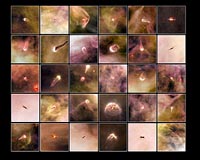 |
Bonn, Germany (SPX) Jan 08, 2010 In the field of archaeology the age of finds or the time of events can sometimes be determined relatively easily, for example via the number of tree rings or the rate of decomposition of radioactive elements. However, there is unfortunately no direct and absolute indicator for the age of the Universe. Astronomers have, however, found two ways to arrive at a good estimate. The Universe is at least as old as the oldest objects within it. What are the oldest objects whose age can be determined? Stars are promising candidates; however, several things must be taken into account. The higher a star's mass, the shorter its lifetime. In addition, many of the stars that are observable today contain chemical elements that are heavier than hydrogen and helium. These stars must have formed later in the history of the Universe's development, because heavy elements did not exist at the very beginning. The heavy elements had to be produced in the first stars or early star generations. (See also the astronomy question from week 36: Are we made of 'stardust'?) As a result, the oldest stars must have only a relatively low mass and contain hardly any heavy elements. Stars such as this can, for example, be found in the globular clusters that are grouped around the Milky Way. In particular, white dwarf stars, which have consumed their nuclear fuel and are slowly cooling down, can be used for age determination. Observations of the globular clusters and the cooling time of white dwarfs allow us to conclude that the age of the Milky Way is approximately 12 billion years.
The Milky Way - only a little younger than the Universe However, cosmic expansion has not always taken place evenly; this would only have been the case in a completely empty Universe. Radiation, matter (including 'dark matter') and dark energy influence this expansion. Astronomers determine these influences using satellite observations, among other things, and ultimately they calculate that the Universe is 13.7 billion years old.
Share This Article With Planet Earth
Related Links German Aerospace Center (DLR) Astronomy News from Skynightly.com
 Born In Beauty: Proplyds In The Orion Nebula
Born In Beauty: Proplyds In The Orion NebulaBoston MA (SPX) Dec 15, 2009 A collection of 30 never-before-released images of embryonic planetary systems in the Orion Nebula are the highlight of the longest single Hubble Space Telescope project ever dedicated to the topic of star and planet formation. Also known as proplyds, or protoplanetary discs, these modest blobs surrounding baby stars are shedding light on the mechanism behind planet formation. Only the ... read more |
|
| The content herein, unless otherwise known to be public domain, are Copyright 1995-2009 - SpaceDaily. AFP and UPI Wire Stories are copyright Agence France-Presse and United Press International. ESA Portal Reports are copyright European Space Agency. All NASA sourced material is public domain. Additional copyrights may apply in whole or part to other bona fide parties. Advertising does not imply endorsement,agreement or approval of any opinions, statements or information provided by SpaceDaily on any Web page published or hosted by SpaceDaily. Privacy Statement |